The Ultimate Guide to Compound Exercises for Mass & Strength
To gain muscle and strength as quickly as possible, it’s not enough to just do any type of exercises—you have to do the right exercises.
And in most cases, that means doing compound exercises.
A compound exercise is any exercise that trains multiple muscles simultaneously. They’re beneficial because they allow you to lift heavy weights safely, which is vital for gaining muscle and strength.
Compound lifts also make your workouts more time-efficient and may even promote a more “anabolic environment” in your body, further boosting muscle gains.
That said, compound exercises aren’t always best. Exercises that train individual muscles—”isolation exercises”—also have a place in any well-designed training routine.
In this article, you’ll learn exactly what a compound exercise is, why they should be the foundation of your training program, the best compound exercises for mass and strength, and more.
- What Are Compound Exercises?
- The Benefits of Compound Exercises
- Compound Exercises vs. Isolation Exercises
- The 7 Best Compound Exercises for Mass
- The Best Compound Exercise Workout Routines
- FAQ #1: Compound vs. Isolation workouts: What’s the difference?
- FAQ #2: Are compound exercises better than isolation exercises?
- FAQ #3: Should you do compound or isolation exercises first?
Table of Contents
+What Are Compound Exercises?
A compound exercise is an exercise that involves multiple joints and muscle groups.
For example, the squat involves moving the knees, ankles, and hip joint and requires a whole-body coordinated effort, with the quadriceps, hamstrings, and glutes bearing the brunt of the load.
In contrast, an exercise that involves just one joint and muscle group is an isolation exercise. A prime example of an isolation exercise is the biceps curl, which involves bending the elbow to train the biceps.
The Benefits of Compound Exercises
One of the biggest fitness mistakes people make is underestimating the importance of compound exercises.
I learned this lesson the hard way.
When I started training, I let bodybuilding blogs and magazines dictate my training, which meant I did a lot of high-rep workouts consisting mainly of isolation exercises.
The picture on the left shows my physique after seven years of this approach. It wasn’t terrible, but it wasn’t impressive either. Soon after, I began focusing on compound weightlifting and cleaned up my diet. The middle picture shows the results after just one year:
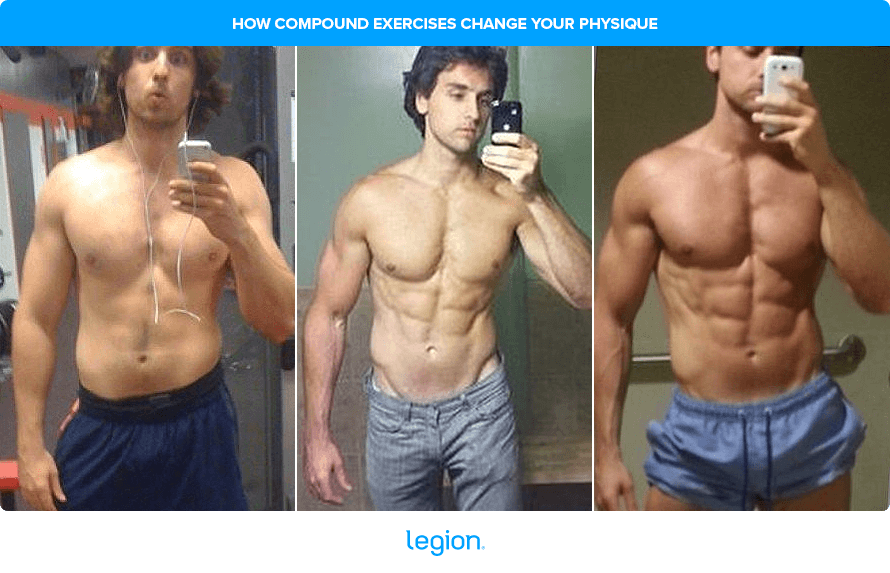
The picture on the right is me after another year or so of heavy compound weightlifting and proper dieting. As you can see, every aspect of my physique improved dramatically, and I became far stronger, too.
Why did compound exercises change my body so significantly?
Here are the main reasons:
- Compound exercises train many muscles at once. The more muscles you train in a single movement, the more muscle you can gain. This also makes for more time efficiency—one compound exercise can replace several isolation exercises.
- They allow you to lift heavier weights. The best compound exercises put dozens of muscles and multiple joints through large ranges of motion. Consequently, you can move more weight than isolation exercises and thus better progressively overload your muscles. This means faster muscle growth.
- They significantly raise testosterone and growth hormone levels. These effects don’t influence muscle gain as much as some people claim, but they’re beneficial nonetheless.
- Compound lifts produce the greatest increases in metabolic rate. As such, they help burn more calories both during and after your workout and may help you lose fat or maintain a low body fat percentage.
Compound Exercises vs. Isolation Exercises
Many fitness experts put compound exercises on a pedestal, as all you need to fully develop every major muscle group in your body. Isolation exercises, they say, may be fun, but they’re superfluous if you do enough squatting, deadlifting, and bench and overhead pressing.
I disagree.
While the lion’s share of your physique can come from compound exercises, by supplementing them with the right isolation exercises, you can gain even more muscle and strength.
Here’s why:
- Isolation exercises allow you to continue training specific muscle groups when it’s no longer practical to do so with compound exercises. For instance, your chest and shoulders will be bushed after several sets of bench and dumbbell pressing, but your triceps will be up to a few sets of pushdowns.
- Isolation exercises allow you to train a muscle group in different positions and through different ranges of motions, which likely improves muscle growth. For example, the pull-up and barbell row train your biceps in a very different way than the hammer and preacher curl.
- Doing the same 3 or 4 exercises every week for months on end gets boring, and boring workouts tend to be less productive than engaging ones.
- Repeating the same exercises in the same way for long periods of time probably increases the risk of repetitive stress injuries, especially with heavier weights.
- Isolation exercises are excellent for addressing muscle imbalances and weak points in your physique. For example, if one arm or leg is stronger than the other, you may not even realize it until you start doing the right isolation exercises (like the leg extension or curl or alternating dumbbell curl or single-arm overhead triceps extension).
Given all of this, the most effective approach I’ve found, both for myself and in training thousands of others, is to spend about 75% of your gym time on compound movements and the remaining 25% on isolation exercises.
The 7 Best Compound Exercises for Mass
Below are the best upper- and lower-body compound exercises for building mass and strength in all your major muscle groups.
Here’s how to perform each exercise, why they’re the best, and how to integrate them into your routine with guidance on sets, rep ranges, and rest periods.
The Best Lower Body Compound Exercises
The following compound lower-body exercises are fantastic for developing glute, quad, hamstring, and calf mass.
Back Squat
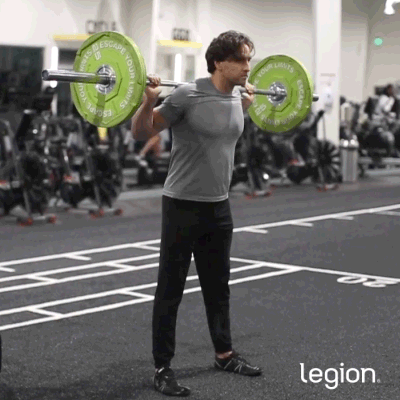
Why: Although the back squat is primarily a compound lower-body exercise, it also trains several upper-body muscle groups, particularly the back and core, which is why many consider it a full-body compound lift. Regardless of how you classify it, the back squat is one of the best compound exercises for building mass throughout your body, especially in your quads and glutes.
How to:
- Position a barbell in a squat rack at about the height of your nipples.
- Step under the bar, pinch your shoulder blades together, and rest the bar above the bony ridges on the bottom of your shoulder blades.
- Lift the bar out of the rack, take 1-to-2 steps backward, and place your feet a little wider than shoulder-width apart with your toes pointing slightly outward.
- Keeping your back straight, sit down and push your knees out in the same direction as your toes.
- Stand up and return to the starting position.
- Sets and reps: 3 sets of 4-to-6 reps with 2-to-4 min rest
Sets and reps: 3 sets | 4-to-6 reps | 2-to-4 min rest
Deadlift
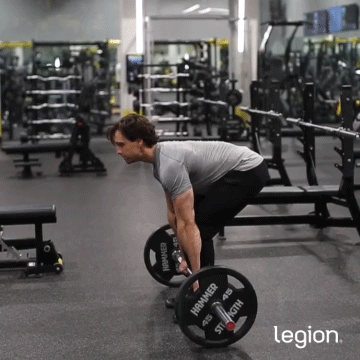
Why: The deadlift allows you to lift heavy weight safely and progress regularly, making it ideal for adding mass to your entire posterior chain (the muscles on the back of your body), especially your hamstrings, glutes, and lower back.
How to:
- Position your feet slightly narrower than shoulder-width apart with your toes pointed slightly out.
- Move a loaded barbell over your midfoot so it’s about an inch from your shins.
- Grip the bar just outside your shins with your palms facing you.
- Flatten your back and drive your body upward and slightly back by pushing through your heels until you’re standing up straight.
- Reverse the movement and return to the starting position.
Sets and reps: 3 sets | 4-to-6 reps | 2-to-4 min rest
Lunge
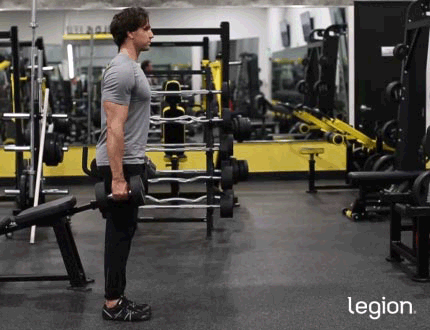
Why: Research shows the dumbbell lunge is one of the best compound dumbbell exercises for building mass in your quads, glutes, and hamstrings. Because it requires greater balance and coordination than most other leg exercises, it also engages many smaller stabilizer muscles throughout your body, helping you develop full-body mass and strength.
How to:
- Holding a dumbbell in each hand, stand with your feet hip-width apart.
- Take a long step forward with your right foot—about 2-to-3 feet. Bend both knees until your left knee touches the floor.
- Reverse the motion by pushing through your right foot and leaning slightly backward, allowing your legs to straighten.
- Once you’re standing, bring your right foot back to the starting position.
Sets and reps: 3 sets of 6-to-8 reps with 2-to-3 min rest
The Best Upper Body Compound Exercises
The following upper-body compound exercises are highly effective for adding mass to all the muscles involved in both pushing away from and pulling toward your torso.
Bench Press
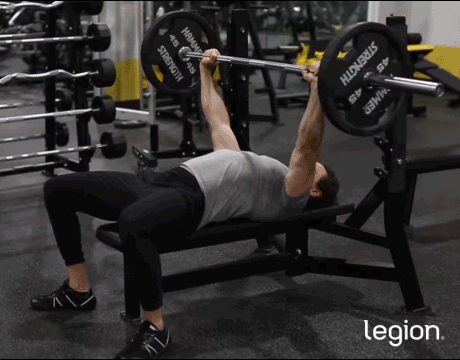
Why: The barbell bench press is one of the single best upper-body compound exercises because it trains every major muscle group above your waist, particularly your pecs, triceps, and deltoids. If you want to add mass to your upper body, the barbell bench press should be part of your routine.
How to:
- Lie on a flat bench and place your feet flat on the floor.
- Pull your shoulder blades together and down, and without lifting your butt or shoulders off the bench, slightly arch your back.
- Grab the bar with a slightly wider than shoulder-width grip and unrack the barbell.
- Lower the barbell to your chest, keeping your elbows tucked 6-to-8 inches from your sides.
- Press the bar back to the starting position.
Sets and reps: 3 sets | 4-to-6 reps | 2-to-4 min rest
Overhead Press
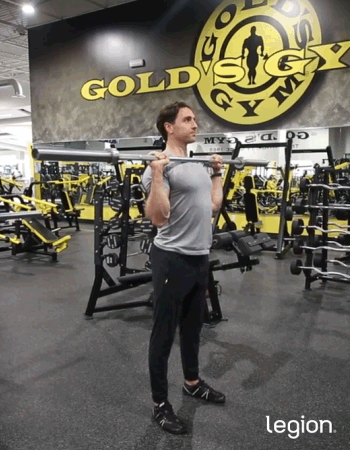
Why: The overhead press is one of the most comprehensive compound upper-body exercises on this list: it improves upper-body strength, builds shoulder, upper back, and tricep size, and enhances whole-body balance and coordination.
How to:
- Set a barbell in a rack at the same height as your upper chest.
- Grip the bar with a shoulder-width grip and your palms facing away from you.
- Unrack the barbell, step backward, and plant your feet just outside of shoulder width.
- Push the bar toward the ceiling until your arms are straight.
- Reverse the movement and return to the starting position.
Sets and reps: 3 sets | 4-to-6 reps | 2-to-4 min rest
Pull-up
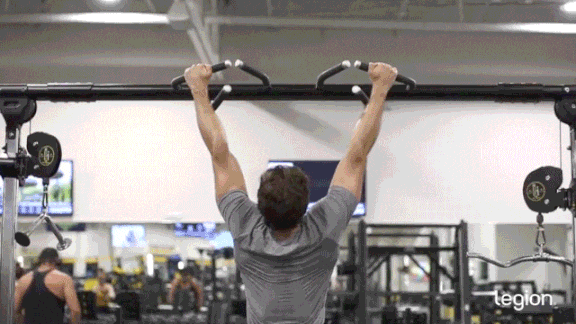
Why: While the pull-up trains most back muscles, it’s particularly effective for adding mass to your lats, which is important for developing an aesthetic “V-taper” many people want.
How to:
- Grab a pull-up bar slightly wider than shoulder-width apart with your palms facing away from you.
- Lift your feet so that you’re hanging with your arms straight.
- Pull your body up until your chin is above the bar.
- Once your chin has passed the bar, reverse the movement and return to the starting position.
Sets and reps: 3 sets | 4-to-6 reps | 2-to-4 min rest
One-Arm Dumbbell Row
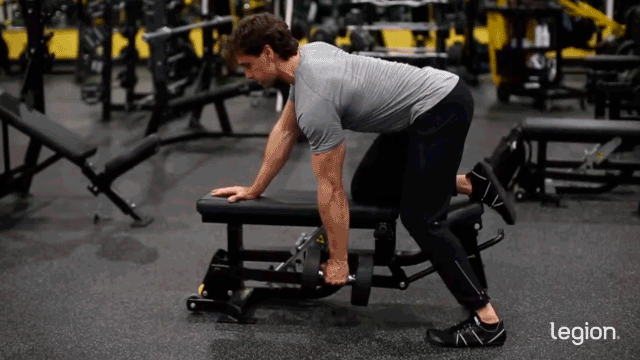
Why: The one-arm dumbbell row trains each side of your back independently, helping you build symmetrical back mass. It can also help you establish a stronger “mind-muscle connection” and may enhance athletic performance more than back exercises that train both sides of your body simultaneously.
How to:
- Hold a dumbbell in your right hand.
- Plant your left knee and hand firmly on a bench, your right foot on the floor a foot or two from the bench, and let your right arm hang straight down toward the floor.
- Keeping your back straight, pull the dumbbell upward until it touches your torso, and then return the dumbbell to the starting position.
- Once you’ve completed the desired number of reps, repeat the process with your left arm.
Sets and reps: 3 sets | 6-to-8 reps | 2-to-3 min rest
The Best Compound Exercise Workout Routines
For workout routines containing the perfect balance of compound exercises and isolation movements, check out the following:
- The Ultimate Guide to the Bigger Leaner Stronger Workout
- The Ultimate Guide to the Thinner Leaner Stronger Workout
- The Best Full-Body Workout Routines for Building Muscle
- The Best 3-, 4- & 5-Day Upper Lower Workout Splits for Mass
- The Ultimate Guide to the Push Pull Legs Workout Routine
FAQ #1: Compound vs. Isolation workouts: What’s the difference?
A “compound workout” typically refers to a routine that consists entirely of compound exercises. These routines are popular among powerlifters and strength athletes who focus on lifting heavy weights and maximizing overall strength.
An “isolation workout,” on the other hand, primarily includes isolation exercises but may still incorporate a few compound lifts. These workouts are more common among bodybuilders who aim to target specific muscles for hypertrophy.
FAQ #2: Are compound exercises better than isolation exercises?
No, compound exercises aren’t inherently better than isolation exercises.
That said, compound exercises should form the foundation of your training because they allow you to lift heavier weights and work multiple muscle groups at once, which helps you gain muscle and strength faster.
However, isolation exercises are essential for training specific muscles, correcting imbalances, and “refining” your physique. Combining both in your routine is the most effective approach for overall muscle growth and strength.
FAQ #3: Should you do compound or isolation exercises first?
In most cases, you should start with compound exercises. They require the most energy and coordination, so doing them first ensures you can lift the heaviest weights with the best form.
After your compound lifts, you can move on to isolation exercises to train any under-stimulated or lagging muscles to ensure you give them the “attention” they need to grow.
The post The Ultimate Guide to Compound Exercises for Mass & Strength appeared first on Legion Athletics.
https://ift.tt/LJ49YUd September 09, 2024 at 06:00PM Legion Athletics
Comments
Post a Comment